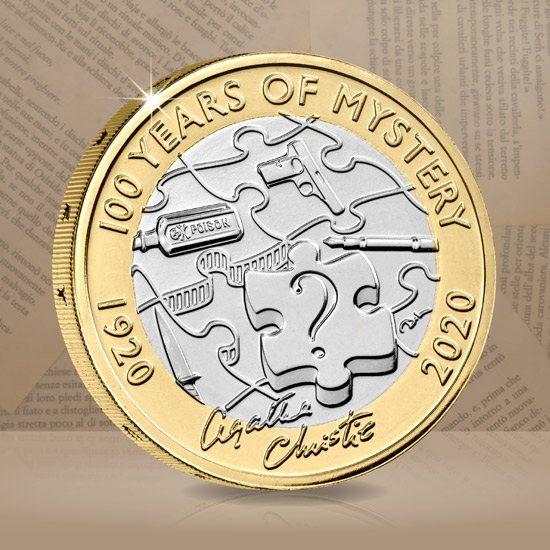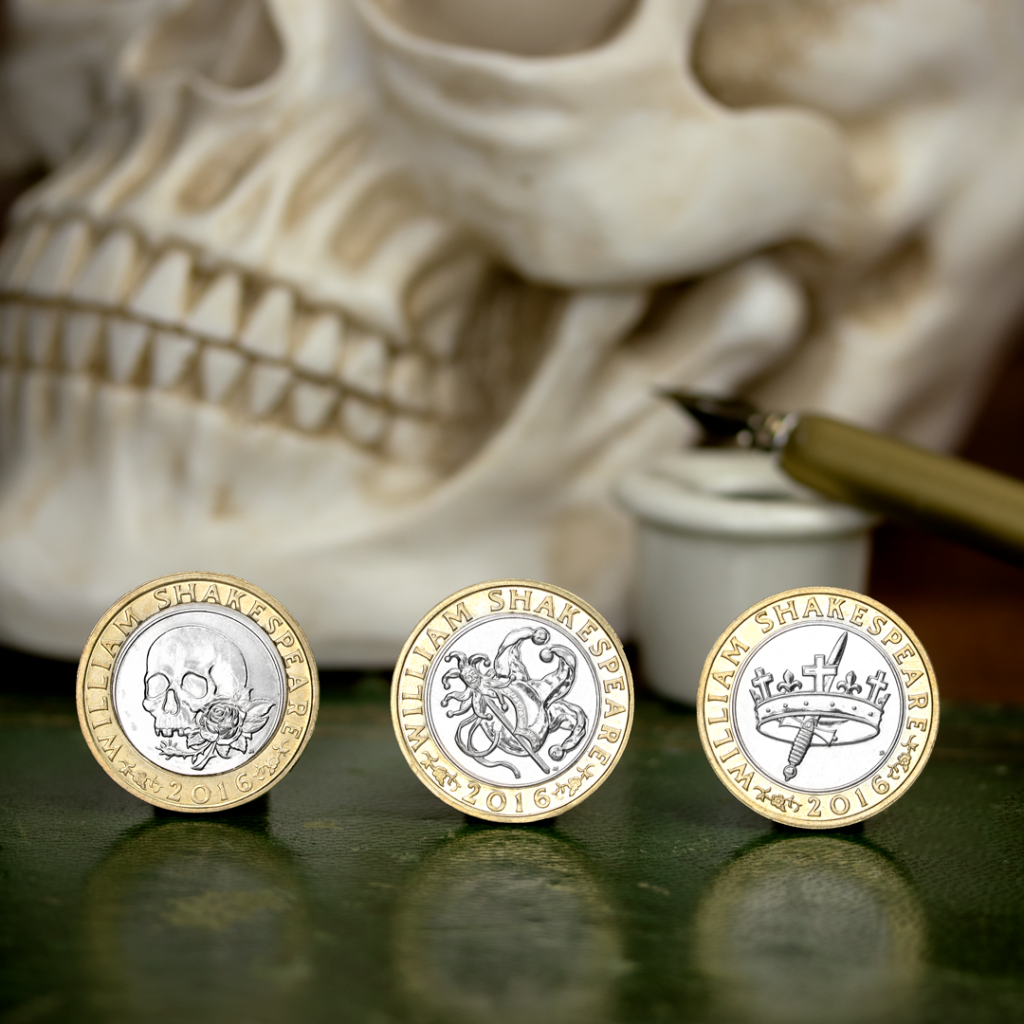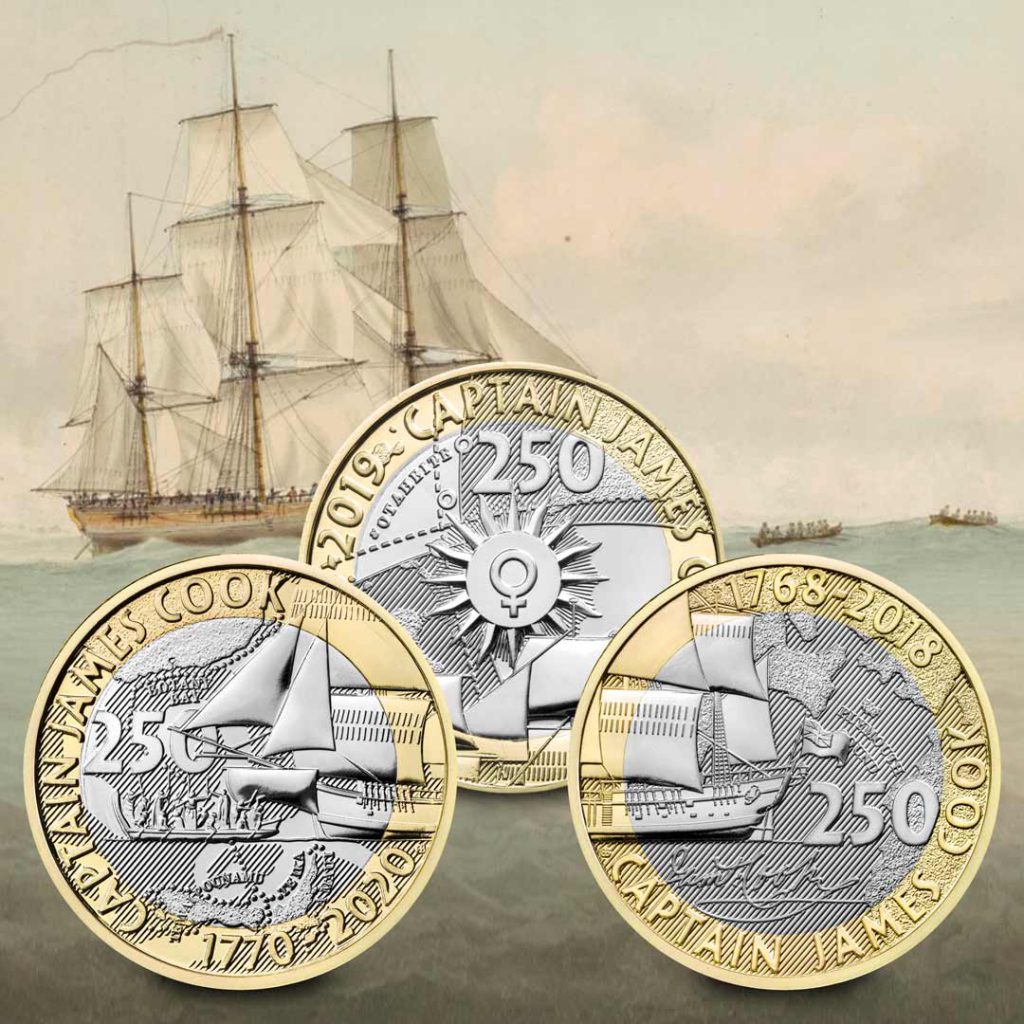£2 Coins
Agatha Christie £2 celebrates 100 years of mystery!
Agatha Christie’s first novel The Mysterious Affair at Styles was published in 1920 and it kick-started the nation’s love of her detective novels and murder mysteries.
In 2020, to mark 100 years since her first publication, The Royal Mint celebrates the world’s best-selling novelist with the 2020 UK Agatha Christie £2.
2020 UK Agatha Christie £2

David Lawrence’s design of this coin pays homage to Christie’s crime novels, with a piece of a jigsaw slotting into place and her signature at the bottom.
The coin also features the edge inscription ‘100 years of mystery 1920’-2020’ to mark this very special anniversary.
Issued initially as part of the 2020 Commemorative Coin Set, this £2 coin was later individually released in Brilliant Uncirculated quality.
Murder, Mystery, and Masterpieces

After the end of the First World War, Christie published her first novel The Mysterious Affair at Styles. This incredibly popular story introduced readers to one of Christie’s most famous characters – Belgian detective Hercule Poirot*.
Writing well into her later years, Christie wrote more than 70 detective novels as well as short fiction. Her books have been made into films, television, and radio programmes. In 1971, she was made a Dame of the British Empire for her outstanding contribution to Literature.

In 2020, she was celebrated once more with this £2 coin and became another UK author to be commemorated on UK coinage…
2016 Shakespeare £2 Series

William Shakespeare is the most influential literary figure in British history and his works are an important part of Britain’s cultural heritage.
In 2016, a series of three £2 coins were issued to mark the 400th anniversary since his death and to celebrate his greatest works.
Each coin’s design takes inspiration from some of Shakespeare’s greatest works, including Macbeth (pictured right), A Midsummer Night’s Dream (central) and his most-famous love tragedy (pictured left).
All three coins entered circulation but the Comedy £2 has the lowest circulating mintage – just 4,355,000!
2017 Jane Austen
In 2017, to celebrate the life and works of one of Britain’s best-loved authors, The Royal Mint issued this Jane Austen £2.
Jane Austen is one of the best-loved English novelists from the 19th century. Her novels were revolutionary and from her first novel, Sense and Sensibility, readers began a love affair with her fiction that has lasted two centuries.
Designed by Dominique Evans, a portrait of Jane Austen features on the reverse of this coin. It did not enter general circulation and was issued in collector quality only.
2019 Sherlock Holmes 50p
In 2019, to mark 160 years since the birth of Sir Arthur Conan Doyle, The Royal Mint issued this 50p coin.
The prolific writer is best known for his incredibly popular detective stories featuring the fictional Sherlock Holmes™. It is said his works revolutionised the crime genre, and despite Doyle sharing an ambivalent relationship with his famous character, Holmes’ popularity resulted in Doyle becoming one of the best-paid authors of the time.
The reverse has been designed by Stephen Raw and features a silhouette of Sherlock smoking a pipe, surrounded by a few of his most-famous story titles.
It entered general circulation and has a mintage of 8,602,000.
2012 Charles Dickens £2
The Charles Dickens £2 coin was issued by The Royal Mint in 2012 to commemorate the 200th anniversary of one of Britain’s most famous and beloved writers.
His enchanting stories, vivid characters and depiction of Victorian life are widely acknowledged across the world by critics and scholars alike and his novels and short stories continue to be widely popular.
The design features Dickens’ recognisable profile crafted from the titles of his most famous works and is a favourite amongst collectors.
This coin was released into general circulation and has a mintage of 8,190,000.
2018 Mary Shelley’s Frankenstein £2
This £2 coin was issued by The Royal Mint to celebrate the 200th anniversary of the publication of Mary Shelley’s famous novel Frankenstein; or, The Modern Prometheus.
Whilst on holiday in Geneva Mary Shelley and her poet friends, including Lord Byron and future Husband Percy Shelley, decided to have a competition to see who could write the best horror story. Out of this Mary Shelley created Frankenstein, a story about a scientist’s scary act at playing God and creating life. It went on to become one of the best loved gothic novels.
The reverse of this gothic coin was designed by Thomas Doherty and features the words ‘Frankenstein’ in an electric gothic font. It features the edge inscription, Bicentenary of Mary Shelley’s The Modern Prometheus. It did not enter general circulation.
2016 Beatrix Potter Anniversary 50p
To celebrate the 150th anniversary of the birth of Beatrix Potter, the Royal Mint have released this 50p to celebrate Beatrix herself.
Designed by Emma Noble, the coin includes elements that celebrate Beatrix as the artist behind some of the best-loved characters in children’s literature along with the nostalgic font used for the inscription.
This coin entered general circulation and has a mintage of 6,900,000.
We love seeing Britain’s best-loved authors come to life on our UK coins, but which author coin is your favourite? Comment below!
Secure the Agatha Christie £2 in the 2020 Annual Set
This coin is no longer available individually, but you can still secure it as part of the 2020 Annual Coin Set >>
The Mayflower sails onto a UK £2 coin!
In 2020, to commemorate the 400th anniversary of the most-famous journey of the Mayflower, The Royal Mint issued this UK £2 coin.
2020 UK Mayflower £2

Chris Costello’s reverse design on this coin depicts the Mayflower’s sails majestically billowing in the wind and the anniversary dates as an inscription – ‘1620-2020’.
Journey to the Unknown
On 16th September 1620, the Mayflower set sail on its famous voyage from Plymouth, England to the ‘New World’ – a key event in British history.

102 Pilgrims and around 30 crew aboard the ship spent two months at sea, battling against the North Atlantic wind on their ground-breaking journey to America. After a 66-day voyage, it first landed November 21 on Cape Cod at what is now Massachusetts.
There are an estimated 10 million living Americans and 35 million people around the world who are descended from the original passengers on the Mayflower.
To mark the 400th anniversary of this British vessel departing Plymouth, this £2 coin brings its history to life once more.
But, eagle-eyed collectors may recognise the iconic Mayflower ship from a previous £2 coin…
1994 Mayflower £2 Trial Piece
The UK’s first bi-metallic coin was issued for general circulation in 1997, but in order to prepare for the change over, a trial piece was struck, to test if tills and vending machines would accept it.

Featuring on the reverse design of this new style of coin, was none-other than the famous Mayflower ship!
Issued in a special presentation pack, the 1994 Mayflower Trial £2 was housed next to samples, demonstrating the different stages of its production.
Just over 4,500 of these packs were issued, making the 1994 Mayflower Trial £2 coin incredibly rare, especially if you compare this to the rarest £2 coin in circulation, the 2002 Commonwealth Games Northern Ireland £2, which has a mintage of 485,500!
But the Mayflower £2 coins aren’t the only nautical themed UK coins we’ve seen…
2011 Mary Rose £2

This £2 coin was in 2011 issued to celebrate the 500th anniversary of the launch of the Mary Rose.
The Mary Rose was a ship built and completed at Portsmouth Harbour in 1511 for Henry VIII and named after his favourite sister, Mary Tudor. It was the pride and joy of England’s Royal Navy but in 1545 it met with a tragic end whilst leading an attack against a French invasion fleet in the Solent.
For reasons still not concluded, the Mary Rose listed to one side and sank with the loss of all but 35 men…
It has a mintage of JUST 1,040,000, making it one of the rarest £2 coins in circulation!
2015 First World War (Navy) £2

In 2014, The Royal Mint announced a new five-year First World War commemoration £2 coin series. This £2 coin was the second coin in this series, issued in 2015, and pays tribute to the Royal Navy.
At the time, it was by far the most powerful navy in the world, and was a major asset to Britain in defending coastal waters against the Germans.
Renowned military artist David Rowlands designed the reverse of this coin, and it features a battleship approaching on the open sea.
It has a circulating mintage of JUST 650,000, making it particularly scarce and hard to come by! So, consider yourself very lucky if you have it in your collection!
Captain Cook £2 Series

This £2 coin series first stared in 2018 to celebrate the 250th Anniversary of the famed British Explorer, Captain Cook, setting sail on his legendary Voyage of Discovery.
Cook’s pioneering expedition for the ‘Great South Land’ expanded our understanding of the world beyond known horizons and 250 years on is being celebrated with this unique £2 coin series.
His famous ship, HM Bark Endeavour features on the design and, just like a secret map, when all three coins in the collection are placed together the design can be seen as a whole!
You can find out more about this incredible series here!
2005 Trafalgar £5 Coin

One of the greatest landmarks in British history, the Battle of Trafalgar was fought on 21st October 1805.
The Battle of Trafalgar was won by the Royal Navy, commanded by Vice-Admiral Horatio Nelson, over the combined French and Spanish fleets.
The Royal Mint marked the bicentenary of this battle with two £5 coins. The first of these designs by Clive Duncan, shows Nelson’s flagship ‘Victory‘ leading the fleet into battle.
HMS Victory is in service to this day as the flagship of the Commander-In-Chief, moored in Portsmouth dockyard!
Let us know in the comments below if you have this £5 coin in your collection!
Secure the Mayflower £2 in the 2020 Annual Coin Set
The Mayflower £2 is no longer available individually, however you can still secure it as part of the 2020 Annual Coin Set >>
Your guide to the Pre-1997 £2 Coins
In 1986, a brand new UK denomination was introduced in the form of a £2 coin.
These original £2 coins were never commonly found in circulation, as they were mainly struck for collectors. This made them much rarer than their successor, the bi-metallic £2 coin, as their mintage figures were much lower.
The pre-1997 £2 coins are still legal tender but they’re not used in circulation and banks/shops can refuse to accept them. Despite this, they still remain incredibly popular amongst collectors!
So, in this blog, we’ve put together a guide to the pre-1997 £2 coins, including everything you need to know about these collectable commemoratives.
What are old specification £2 coins?
The £2 coin has changed in its appearance since it’s first introduction in 1986…
The familiar, fully circulating bi-metallic £2 coin, was only introduced in 1998 and we’ve seen already seen over 50 different designs in total!
But prior to this, single-coloured, nickel-brass £2 coins were issued, purely to mark special occasions.
Between 1986 and 1996, there were seven different designs of the single-coloured £2 coins.

Spot the difference…
| Pre-1997 (old specification) | 1997 onwards (new specification) | |
| Weight | 15.976g | 12g |
| Diameter | 28.4mm | 28.4mm |
| Metal | Nickel-brass | Outer Nickel-Brass Inner Cupro-Nickel |
| Obverse Effigy | 1969-1985 – 2nd Portrait, Arnold Machin 1985-1997 – 3rd Portrait, Raphael Maklouf | 1997-2015 – 4th Portrait, Ian Rank-Broadley 2015-onwards – 5th Portrait, Jody Clark |
As you can see, although the diameter of the £2 coin stayed the same, the weight was significantly heavier in the pre-1997 £2 coins!
The metal composition also changed so that the new bi-metallic coin could be distinguishable from the other coins in circulation.
So, how many of these coins were issued? Let’s take a look at our Pre-1997 £2 Mintage Chart and see..

You might have spotted the top coin in our chart has a mintage of JUST 381,400! Let’s take a look at each of these coins in closer detail to get the full story…
1986 Commonwealth Games
Fact file:
- Year of issue: 1986
- Obverse designer: Arnold Machin
- Reverse designer: Norman Sillman
- Mintage: 8,212,184

The 1986 Commonwealth Games £2 coin changed the face of UK commemorative coins, being the first of its denomination to be struck and the first British coin being issued to commemorate a sporting event.
The thirteenth Commonwealth Games were held in Edinburgh in 1986, and are well remembered for being boycotted by 32 of the 59 eligible countries who did not agree with Britain’s sporting connections to South Africa during the Apartheid era.
The reverse design features a thistle encircled by a laurel wreath over the cross of St Andrew.
1996 Football
Fact file:
- Year of issue: 1996
- Obverse designer: Raphael Maklouf
- Reverse designer: John Mills
- Mintage: 5,141,350

In 1996, England hosted the 10th European football championship and a commemorative £2 coin was struck in celebration of football.
The reverse design resembles a football, and is accentuated by the unusual concave surface of the coin. The year of 1996 is prominent on the design and the sixteen small rings represent the sixteen teams competing in the tournament.
The eventual winners of the competition were Germany who knocked out hosts England in the semi-finals.
1995 Peace
Fact file:
- Year of issue: 1995
- Obverse designer: Raphael Maklouf
- Reverse designer: John Mills
- Mintage: 4,394,566

This commemorative £2 was issued in 1995 to mark 50 years since the end of World War II.
Victory in Europe Day, or VE Day, is the 8th May 1945 when armed forces formally accepted the surrender of Nazi Germany. Upon the news, jubilant crowds sang and danced in the streets of London, New York, Paris and Moscow.
The reverse design by John Mills features a dove as “a symbol of aspiring peace; a calm, bountiful and optimistic image”.
1989 Bill of Right
Fact file:
- Year of issue: 1989
- Obverse designer: Raphael Maklouf
- Reverse designer: John Lobban
- Mintage: 4,392,825

In 1689, Prince William and Mary accepted the Declaration of Rights prior to being offered the throne. This effectively shifted the balance of power from the Crown to Parliament and changed the course of British political history.
This £2 coin was issued in 1989 to commemorate the 300th anniversary of this landmark Act. There were 2 versions of the coin issued – English and Scottish.
This coin is the English reverse design , which features the Crown of St. Edward and the inscription ‘Tercentenary of the Bill of Rights’
1995 United Nations
Fact file:
- Year of issue: 1995
- Obverse designer: Raphael Maklouf
- Reverse designer: Michael Rizzello
- Mintage: 1,668,575

The United Nations was established in the aftermath of World War II with the aim of maintaining world peace and to work for social progress.
Since its creation in 1945, the UN has sought to resolve potential conflicts peacefully and fight against poverty, hunger and disease across the world.
This commemorative £2 coin issued in 1995 marks 50 years since the inception of the UN, and features flags of nations accompanying the 50th anniversary symbol.
1994 Bank of England
Fact file:
- Year of issue: 1994
- Obverse designer: Raphael Maklouf
- Reverse designer: Leslie Durbin
- Mintage: 1,668,575

When William and Mary came to the throne, public finances were weak and the system of money and credit were in disarray.
The Bank of England was founded in 1694 to act as the Government’s banker and debt manager, and its position as the centre of the UK’s financial system is maintained to this day.
This commemorative £2 was issued in 1994 to mark its 300th anniversary. The reverse design features the original Corporate Seal of the Bank of England and distinctive Cypher of William and Mary.
1989 Claim of Right
Fact file:
- Year of issue: 1989
- Obverse designer: Raphael Maklouf
- Reverse designer: John Lobban
- Mintage: 381,400

This is the second coin to be issued in 1989 to commemorate the 300th anniversary of Prince William and Mary accepting the Declaration of Rights.
This Scottish reverse design features the Crown of Scotland and the inscription ‘Tercentenary of the Claim of Right’.
The mintage for this £2 however, is much lower. With just 381,400 issued, this technically makes it the rarest £2 coin ever! In comparison, the UK’s current rarest circulating £2 coin, the 2002 Commonwealth Games – Ireland, has a mintage of 485,500!
So hopefully our guide to the Pre-1997 £2 coins will help you along the way to expanding your collection!
What’s most exciting about all seven of these coins is that despite still being legal tender, they’re not used in circulation anymore and banks/shops can refuse to accept them. This makes these coins particularly sought-after by collectors!
Do you have any of these coins in your collection already? Let us know in the comments below!








